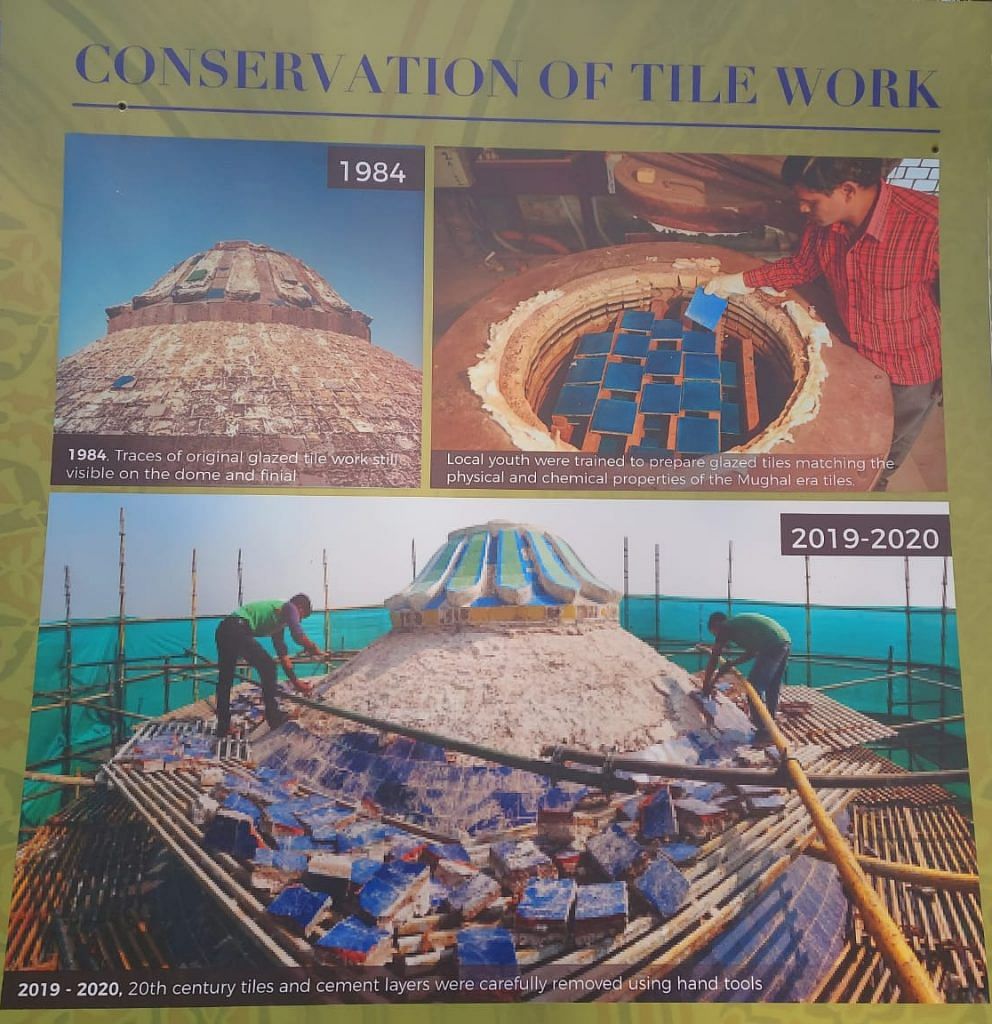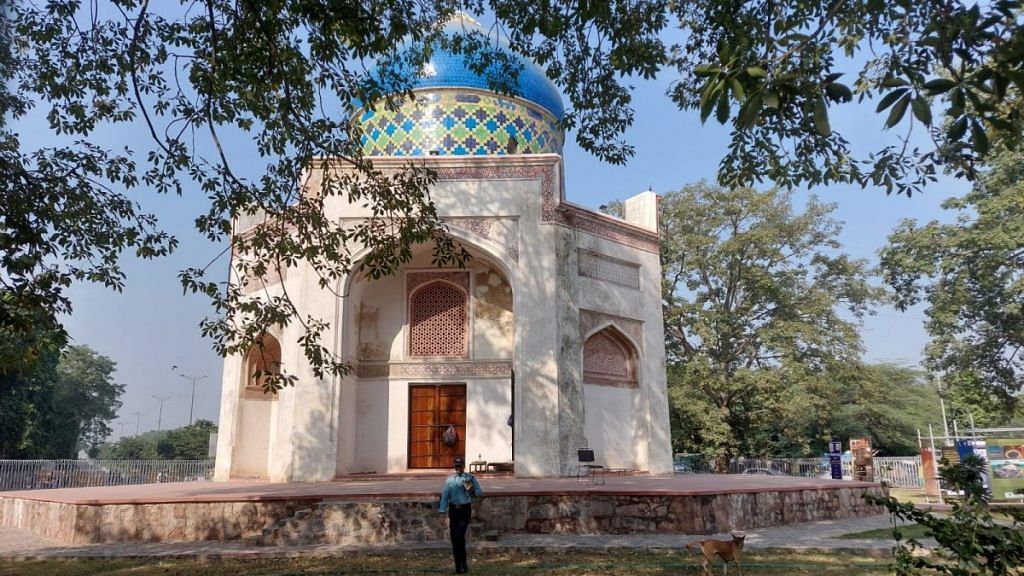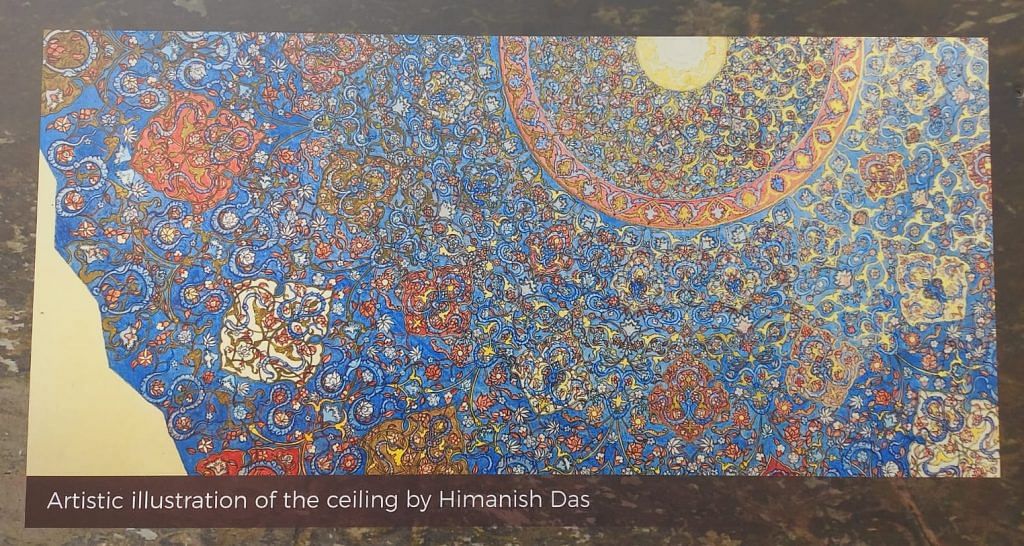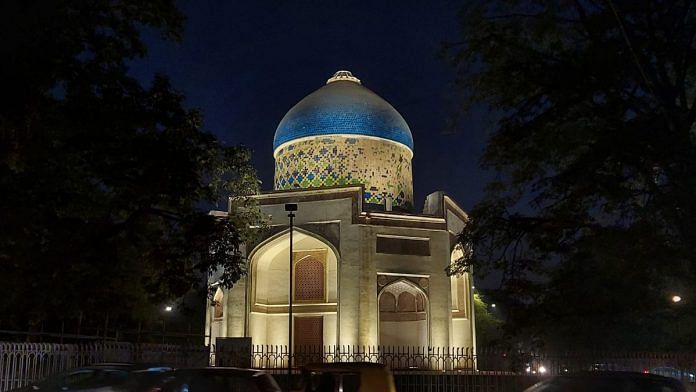A Mughal-era monument’s shining blue ceiling has just revealed itself to the people of Delhi. For a long time, Sabz Burj was a police station and six million vehicles drove past it every year. It was just that overlooked monument at a busy junction of Mathura Road and Lodhi Road near the Nizamuddin area.
And Sabz Burj, which means green dome, is actually blue.
After more than three years of restoration work by the Aga Khan Foundation, Sabz Burj, popularly known as Neela Gumbad or Neeli Chhatri, finally opened for visitors last week. What makes it special is its elongated drum and the intricate blue and gold painting that manifested itself during the restoration work.
Decorated atop with an inverted lotus flower that stands on an elongated drum, the tiles on the dome are a mixture of shining blue and turquoise. The neck of the drum, on which the dome stands, is adorned with tiles set in geometrical patterns in four colours — yellow, green and two shades of blue. The restoration work was taken up by the Aga Khan Trust for Culture in 2018, along with the Archaeological Survey of India and Havells India Limited. It stands proud in an area doted with stunning Mughal architecture — from the Humayun’s Tomb to the Sunder Nursery.
“There is no building of this kind in Delhi with an elongated drum and a lot of tile work. There is a painted ceiling, which is unlike anything else in this area… the painting inside was made with real lapis and gold, and some of it is still visible. Much of it has actually been lost, which is why the conservation had to be taken up,” Ujwala Menon, project manager of the Nizamuddin Basti Urban Renewal Project at the Aga Khan Trust, told ThePrint.

“Subz Burj is an integral part of the Humayun’s Tomb redeveloped project as it is situated at a location that seems to announce the entry into the monument. Its architectural style resembles that of the Timurid dynasty (of the Turkic-Mongol origin), and is perhaps one of the early buildings of the Mughal era”, Menon said.
The conservation of the Burj also marks the first-ever conservation of a national monument with Corporate Social Responsibility (CSR) funds. Havells India provided illumination to the structure to enhance the night skyline of the historic precinct.
The restoration work was part of a decade-long effort by the Aga Khan Trust at the Humayun’s tomb-Nizamuddin area.
“We have been working in the Nizamuddin area for quite some time… It started with the restoration of the gardens of Humayun’s tomb. In 2007, we started working on the Humayun’s Tomb project, which has grown into what we call the Nizamuddin Urban Renewal Project”, says Menon.
Also Read: Delhi’s Nizamuddin — a bustling blend of history and spirituality, until Covid-19 struck
The unique location of Sabz Burj
Anyone visiting Humayun’s Tomb or Sunder Nursery, which has become Delhi’s favourite hang-out spot, can see the monument easily. Unfortunately, not many know about its history and architectural heritage.
Many visitors, who came to the two famous spots, were not entirely aware of the Sabz Burj. ThePrint spoke to several tourists and local people, and only a few could identify it correctly. Mohammad Nasir, an auto-rickshaw driver from the nearby Nizamuddin Basti, told ThePrint that the monument is popularly known as Neela Gumbad.
“We know that it was covered for a few years, and has now been opened. We have also heard that there is a tunnel under it, and when you go inside the mausoleum, your voice echoes,” he says.

Rajesh Kumar, a gol gappa stall owner outside the Humayun’s tomb complex, says he has seen only a few people visiting the newly renovated monument. “Some people, who have interest in these kinds of buildings, do come and see it if they come to Humayun’s tomb. I think the problem is that there are a lot of vehicles passing by, and it is not easy to cross the road peacefully. Maybe that is why people only see it from the outside,” Kumar says. A survey done by the Aga Khan Trust revealed that nearly six million cars cross the monument annually.
“Originally this would have not been situated at a roundabout, this was probably a part of a garden around the Humayun’s tomb area. It is a pity that people cannot reach the monument easily, but that has also acted as an advantage because fewer people visiting means that a lot of the work is preserved much better. It is really iconic in terms of its location,” says Menon.
Nishtha Joshi, a heritage walk curator who came to visit Humayun’s tomb, said people need to be made aware of such monuments because Delhi is much more than just Qutub Minar and Lal Qila.
“I am actually planning to do a tour with young students of the Nizamuddin Basti area, which also includes the Sabz Burj. I remember when in 2018 Sunder Nursery first came up, it was not so hyped. I am sure, be it this monument or the tomb of Abdul Rahim Khan-e-Khana, more people will visit if we create enough awareness,” she tells ThePrint.
Also Read: Sunder Nursery isn’t just the new Khan Market. It’s Delhi’s paradise in a pandemic
Restoration work
The dome acted as a police station in the 20th century, during which much of its architectural character was lost due to repairs and poor conservation efforts. It also suffered loss and vandalism, and there is no information available on who made it. A mausoleum usually houses a gravestone, but Sabz Burj doesn’t seem to have it. The restoration work has surprisingly revealed a printed ceiling in pure gold and lapis among other elements, which is also thought to be the earliest surviving painted ceiling of any monument in India.
“The decoration that one can see over here — the painted ceiling, the differing incised plaster patterns on each of the eight facades and beautiful tile work — is not observed in many historical monuments. Usually, you might see a combination of the two of these, but you usually don’t see all three. This indicates that it was probably made for somebody very important in the Mughal court,” Menon says.

The restoration work included removal of the 20th-century cement layers, tilework matching the physical and chemical properties of the 16th-century tiles and retaining the original tiles, even if they had lost their glaze.
There is a small garden that surrounds the Burj, which is not always open for visitors.
Shahana Khan, a resident of the Nizamuddin Basti, who runs a pan thela right in front of the Burj, hopes illuminating the structure will invite more people.
“Since the past few days, at night, a couple of cars stop by to take pictures. When they get out, they also buy something from us. Not many people visit during the day, but I hope this will bring more people here at night and our customers will also increase,” she says.
She is right. Sabz Burj at night looks like a beautiful painting, standing tall and speaking volumes about what Delhi means for so many of its residents — a cruel yet beautiful reminder of how it survived and flourished amid neglect and decay.
(Edited by Srinjoy Dey)






